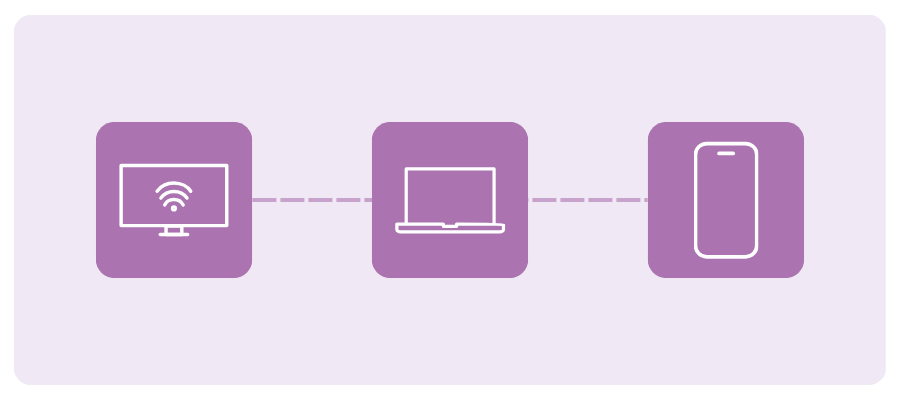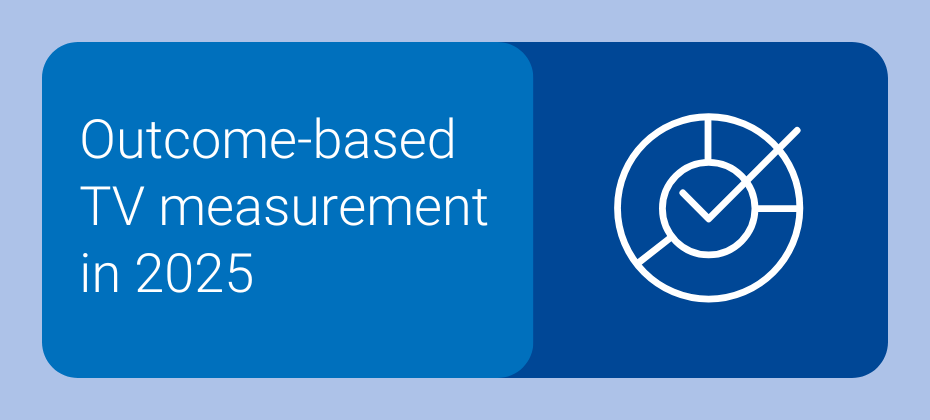At A Glance
Infillion and Experian collaborate to help advertisers connect with audiences across devices and channels, as cookies and mobile identifiers disappear. By integrating Experian's Digital Graph and Offline Identity Resolution, Infillion strengthens identity connections, improves campaign reach, and enhances audience engagement across CTV, mobile, and web.In our Ask the Expert Series, we interview leaders from our partner organizations who are helping lead their brands to new heights in AdTech. Today’s interview is with Ben Smith, VP of Product, Data Products at Infillion.
Adapting to signal loss
What does the Experian–Infillion integration mean for advertisers looking to reach audiences as signals fade?

As cookies and mobile identifiers disappear, brands need a new way to find and reach their audiences. The Experian integration strengthens Infillion’s XGraph, a cookieless, interoperable identity graph that supports all major ID frameworks, unifying people and households across devices with privacy compliance, by providing a stronger identity foundation with household- and person-level data. This allows us to connect the dots deterministically and compliantly across devices and channels, including connected TV (CTV). The result is better match rates on your first-party data, more scalable reach in cookieless environments, and more effective frequency management across every screen.
Connecting audiences across channels
How does Experian’s Digital Graph strengthen Infillion’s ability to deliver addressable media across channels like CTV and mobile?

Experian strengthens the household spine of XGraph, which means we can accurately connect CTV impressions to the people and devices in that home – then extend those connections to mobile and web. This lets us plan, activate, and measure campaigns at the right level: household for CTV, and person or device for mobile and web. The outcome is smarter reach, less waste from over-frequency, and campaigns that truly work together across channels.
The value of earned attention
Infillion has long championed “guaranteed attention” in advertising. How does that philosophy translate into measurable outcomes for brands?

Our engagement formats, such as TrueX, are based on a simple principle: attention should be earned, not forced. Viewers choose to engage with the ad and complete an action, which means every impression represents real, voluntary attention rather than passive exposure. Because of that, we consistently see stronger completion rates, deeper engagement, and clearer downstream results – like lower acquisition costs, improved on-site behavior, and measurable brand lift.
To take that a step further, we measure attention through UpLift, our real-time brand lift tool. UpLift helps quantify how exposure to a campaign influences awareness, consideration, or purchase intent, providing a more complete picture of how earned attention translates into business impact.
Creative innovation and location insights
Beyond identity resolution, what are some of Infillion’s capabilities, like advanced creative formats or location-based insights, that set you apart in the market?

One key area is location intelligence, which combines privacy-safe geospatial insights with location-based targeting through our proprietary geofencing technology. This allows us to build custom, data-driven campaigns that connect media exposure to real-world outcomes – like store visits and dwell time – measured through Arrival, our in-house footfall attribution product.
We also build custom audiences using a mix of zero-party survey data, first-party location-based segments, and bespoke audience builds aligned to each advertiser’s specific strategy.
Then there’s creative innovation, which is a major differentiator for us. Our high-impact formats go beyond static display, such as interactive video units that let viewers explore products through hotspots or carousels, rich-media ads that feature polls, quizzes, dynamic distance, or gamified elements, and immersive experiences that encourage active participation rather than passive viewing. These creative formats not only capture attention but also generate deeper engagement and stronger performance for a variety of KPIs.
Future ready media strategies
How does Infillion’s ID-agnostic approach help brands future-proof their media strategies amid ongoing privacy and tech changes?

We don’t put all our eggs in one basket. XGraph securely unifies multiple durable identifiers alongside our proprietary TrueX supply to strengthen CTV household reach. This agnostic design allows us to adapt as platforms, regulations, and browsers evolve – so you can preserve reach and measurement capabilities without getting locked into a single ID or losing coverage when the next signal deprecates.
Raising the bar for media accountability
Looking ahead, how is Infillion evolving its platform to meet the next wave of challenges in audience engagement and media accountability?
From an engagement standpoint, we’re expanding our ability to support the full customer journey, offering ad experiences that move seamlessly from awareness to consideration to conversion. That includes smarter creative that adapts to context, intelligent targeting and retargeting informed by real data, and formats designed to drive measurable outcomes rather than just impressions.
When it comes to accountability, we’re ensuring that measurement is both flexible and credible. In addition to our proprietary tools, we partner with leading third-party measurement providers to validate results and give advertisers confidence that their investment is truly performing. Within our DSP, we emphasize full transparency and log-level data access, ensuring advertisers can see exactly what’s happening on every impression.
All of this builds toward the next era of agentic media buying – one enabled by our MCP suite and modular, component-based tools. This evolution brings greater accountability and next-generation audience engagement to an increasingly automated, intelligent media landscape. Our goal is to help brands connect more meaningfully with audiences while holding every impression – and every outcome – to a higher standard of transparency and effectiveness.
Driving impact across the funnel
What is a success story or use cases that demonstrate the impact of the Experian–Infillion integration?
We recently partnered with a national veterans’ organization to raise awareness of its programs for injured or ill veterans and their families. Using the Experian integration, we combined persistent household- and person-level identifiers with cross-device activation to reach veteran and donor audiences more precisely across CTV, display, and rich media. The campaign achieved standout results – industry-leading engagement rates, a 99% video completion rate, and measurable lifts in both brand awareness (3.6 % increase) and donation consideration (13.7% lift). It’s a clear example of how stronger identity and smarter activation can drive meaningful outcomes across the full funnel.

Contact us
FAQs
Identity resolution ensures accurate connections between devices, households, and individuals. Experian’s Offline Identity Resolution and Digital Graph strengthen these connections for improved targeting and consistent measurement across CTV, mobile, and web.
Solutions like Experian’s Digital Graph enable brands to connect first-party data to household and person-level identifiers, ensuring scalable reach and compliant audience targeting legacy signals fade.
Focusing on earned attention (where audiences actively choose to engage) leads to stronger completion rates, improves on-site behavior, and drives measurable increases in brand awareness and consideration.
By linking CTV impressions to households and extending those connections to mobile and web, Experian’s identity solutions ensure campaigns work together seamlessly, reducing over-frequency and improving overall reach.
About our expert

Ben Smith, VP Product, Data Products
Ben Smith leads Infillion’s Data Products organization, delivering identity, audience, and measurement solutions across the platform. Previously, he was CEO and co-founder of Fysical, a location intelligence startup acquired by Infillion in 2019.
About Infillion

Infillion is the first fully composable advertising platform, built to solve the challenges of complexity, fragmentation, and opacity in the digital media ecosystem. With MediaMath at its core, Infillion’s modular approach enables advertisers to seamlessly integrate or independently deploy key components—including demand, data, creative, and supply. This flexibility allows brands, agencies, commerce and retail media networks, and resellers to create tailored, high-performance solutions without the constraints of traditional, all-or-nothing legacy systems.
Latest posts

In a perfect world, we’d all have a single, go-to grocery store that carried everything on our shopping list – fresh produce, gourmet coffee beans, rare spices, and maybe even that special-grade olive oil, right alongside our wholesale bulk purchases at unbeatable prices. It would be convenient and efficient, and it’d save a lot of driving around town. The changing data marketplace: From one-stop shop to specialized selection For a long time, data buyers enjoyed something similar in their world: a small set of large-scale data marketplaces that offered a wide array of audiences, making it easy to load up on whatever you needed in one place. Not only are there fewer places to pick everything up, but new factors like privacy and signal deprecation are placing a spotlight on quality and addressability. Just as our dinner plans are growing more ambitious insofar as we want health, flavor, value, and convenience all in one place – so are our data strategies. Instead of a single steak-and-potatoes meal, today’s data marketplace operators might be cooking up a complex menu of campaigns. As a result, data buyers are beginning to shop around. Some still rely on large-scale marketplaces for familiar staples, but now they have reasons to explore other options. Some are turning to providers known for offering top-tier, transparently sourced segments. Others are focusing on specialty providers that excel in one area. A more selective approach to data buying In this environment, choosing where to “shop” for data is becoming more deliberate and selective. Data buyers aren’t just thinking about broad scale; they’re looking to prioritize quality, durability, data privacy, and differentiation. They need to place higher value on data marketplaces that can maintain audience addressability over time, despite signal loss. Sometimes, that means accepting a smaller assortment in exchange for tighter vetting and more reliable targeting. Other times it means mixing and matching – stopping by one marketplace for premium segments and another for cost-friendly, wide-reaching data sets. Either way, they can benefit from having more choices. Experian’s marketplace: A trusted source for high-quality data Experian’s vetted and curated blend of data partners and vertically-aligned audiences offers a trusted specialty store for data buyers. Experian’s marketplace, powered by identity graphs that include 126 million households, 250 million individuals, and 4 billion active digital IDs, enables partner audiences to be easily activated and maintain high addressability across display, mobile, and connected TV (CTV) channels. In particular, Experian’s marketplace provides: Enhanced addressability and match rates All audiences delivered from the marketplace benefit from our best-in-class offline and digital identity graphs, which ensure addressability across all channels like display, mobile, and CTV. Unlike other data marketplaces, Experian ensures all identifiers associated with an audience have been active and are targetable, improving the accuracy of audience planning. Audience diversity and scale Access a broad range of audiences across top verticals from our partner audiences, which can be combined with one another and with 2,400+ Experian Audiences. The ability to join audiences across data providers ensures that buyers can build the perfect audience for the campaign. Trusted compliance and oversight With decades of experience, Experian is a trusted expert in data compliance. Our rigorous data partner review ensures available audiences comply with all federal, state, and local consumer privacy regulations. The future of data marketplaces: Precision and flexibility matter The evolution of data marketplaces reflects the industry's shifting priorities. Data buyers seek specificity, reliability, and adaptability to align with their diverse campaign needs. The best data strategy, much like the best grocery run, isn’t about grabbing everything in one place – it’s about carefully selecting the right ingredients to create the perfect recipe for success. This shift underscores the importance of flexibility and precision as data buyers navigate a landscape shaped by privacy regulations, signal loss, and evolving consumer expectations. As data marketplaces adapt to meet these demands, they are redefining what it means to deliver value. Experian’s marketplace enables buyers to strike the perfect balance between reach and quality by offering enhanced match rates, precise audience planning, and seamless distribution. In this new era, data buyers have the tools and options to craft campaigns that are impactful and aligned with the increasingly selective and privacy-conscious digital landscape. The key is recognizing that today’s data strategy is about utilizing the strengths of many to create a cohesive and effective whole. If you're interested in learning more about Experian's marketplace or becoming an active buyer or seller in our marketplace, please contact us. Contact us Latest posts

Conventional TV advertising campaigns have historically relied on general audience metrics like impressions and ratings to measure outcomes. These metrics can help marketers understand how many people have seen an ad, but they don’t reveal its real-world impact, which leaves a gap between ad exposure and results. Outcome-based TV measurement bridges this gap and helps marketers tie ad spending directly to their business goals. Instead of counting eyeballs alone, TV measurement zeroes in on what viewers do after seeing an ad — whether signing up for a service, visiting your website, or purchasing a product. TV ad measurement helps marketers adjust campaigns based on clear, trackable outcomes rather than guesswork. Let’s talk about how marketers can get started with outcome-based TV measurement and start experiencing tangible results. Why outcome-based TV measurement matters Outcome-based measurement indicates a massive shift in how marketers evaluate TV advertising success. As a principal analyst at Forrester explained, the industry is about to “move into a whole different world" where multiple metrics are tailored to advertisers’ unique goals, such as sales, store traffic, or web engagement. This shift is driven by improved tools for tracking TV outcomes, which help justify spending and clarify ROI. With TV measurement, you can see how your campaigns impact aspects of your marketing like sales and engagement. Aligning TV ad spend with business goals Every business has distinct objectives. Outcome-based measurement ties your marketing efforts to business goals and enables smarter decisions, campaign optimization, and ROI improvements. Whether you're a B2C brand wanting immediate sales or a B2B organization looking to drive website traffic, this method provides the insights needed for strategic decision-making. Marketers can deliver the most value by adjusting TV ad spending to maximize desired results: Sales goals: Identify which ads and platforms directly influence purchases to ensure TV ad spend contributes to revenue growth. Customer engagement: Link actions like website visits or app downloads to TV campaigns and refine messaging to deepen audience connections. Desired outcomes: Align ad spend with goals like consumer awareness or repeat purchases to allocate resources effectively for measurable success. Reducing wasted spend on ineffective channels Outcome-based TV measurement allows you to pinpoint which networks, times, or programs drive the most engagement and conversion. When you know your underperforming channels, you can reallocate budgets to those with a higher ROI and avoid waste. Core metrics in outcome-based TV measurement The effective implementation of outcome-based measurement requires advanced TV advertising analytics and tracking metrics that shed light on TV ad performance. Incremental lift This metric measures the increase in desired actions and business results — like purchases or site visits — that can be attributed directly to a TV campaign. Incremental lift quantifies your campaign’s impact and separates organic activity from the results your ads have driven. Let’s say a meal kit service experiences a 20% lift in subscriptions within a single week of running TV ads compared to a week without ads. They’d want to be able to isolate the impact of their ad from their organic growth so they can determine if the growth is actually a result of the TV ads or another effort. Attribution and conversions Attribution links TV ad exposure to specific customer actions, such as newsletter sign-ups and product purchases. Conversion data helps marketers understand the whole customer journey to optimize messaging, targeting, and channel mix to improve conversion rates. A retailer that knows 50% of TV ad viewers visit its e-commerce site within 36 hours of exposure could use that information to adjust the timing of its retargeting and align with site visit spikes. Audience segmentation for targeted measurement Outcome-based measurement breaks down performance across target demographics and allows for granular audience segmentation so TV ads resonate with the right audiences. For example, if a luxury brand saw better TV ad performance with high-earning Millennials, they’d want to refine their campaign messaging based on this group’s habits and preferences. Customer journey tracking Knowing how viewers move from awareness to conversion is critical. Outcome-based TV measurement helps you track the customer journey by pinpointing touchpoints where engagement happens and tying these to your TV campaigns. If a fitness brand found that TV campaigns drive app downloads, it could combine app analytics and TV exposure data to find out when most of their conversions happen after ad exposure and create follow-up messaging for that window of time. Integrating these insights with other marketing channels allows you to fine-tune your messaging, channel mix, and audience targeting to drive better outcomes and deliver more personalized customer experiences. Lifetime value (LTV) Beyond immediate conversions, outcome-based TV ad measurement helps brands identify which TV campaigns attract high-value customers with long-term revenue potential. If a financial institution ran a TV ad campaign centered on its new credit card, for instance, it could use LTV to track new cardholders and determine whether ads occurring during financial news airtime produced customers with higher average annual spend compared to other segments. How outcome-based TV measurement works Outcome-based measurement is a data-driven process that involves collecting, analyzing, and applying insights to improve TV ad performance. 1. Collect data When someone sees your TV ad, they might take action, like downloading your app or buying something. Outcome-based TV measurement begins by tracking these actions and gathering data from various sources, such as: TV viewership CRM Digital engagement Purchase behavior Cross-platform interactions And more Data integration with digital platforms Combining TV data with insights from platforms like social media or website analytics creates a more unified view of campaign performance. This integration powers easier retargeting and better alignment between digital and TV advertising strategies. Some marketers enhance this integration further using artificial intelligence (AI) to streamline data coordination and ensure campaigns are optimized for effectiveness and ROI. 2. Connect the dots Next, marketers need to find out which actions were influenced by TV ads. It’s important to ask questions like these as you work to connect the dots: Did website traffic spike right after the ad aired? Did the ad viewers match the people who signed up for the service or made a purchase? You can link TV exposure to real-world behaviors with tools and identifiers like hashed emails, device IDs, surveys, and privacy-safe data-matching techniques. 3. Analyze the data Then, the data needs to be analyzed for patterns like these: Which TV ads or time slots drove the most engagement? Did certain customer groups respond better than others? Was there a noticeable lift in sales or signups after the ad campaign? This step can help you uncover what’s working and what’s not. Role of advanced analytics and machine learning The data analysis required in this process can be overwhelming, time-consuming, and risky without the right tools. Fortunately, advanced analytics and fast, effective artificial intelligence tools can process large amounts of data from digital platforms, TV viewership, and customer interactions in less time to reveal accurate, actionable insights and patterns. They can also predict which audiences, messages, and channels will be most profitable so campaigns can adapt in real time, whether by reallocating spend to higher-performing channels or refining audience targeting. 4. Turn insights into action Once you have your data-derived insights, you can tweak your campaign in a number of ways, whether you decide to: Adjust your ads: If one message works better than another, lean into it. Refine your targeting: Focus on the audience segments most likely to act. Optimize your spend: Invest in channels or times that deliver the best return. For example, if you see that ads during prime time lead to more purchases than morning slots, you can shift your budget accordingly. This type of knowledge can be used to continuously improve your campaigns. Each time you run a new ad, you measure again, building on past insights to make your outcome-based TV advertising even smarter. Applications of outcome-based TV measurement Outcome-based TV measurement has wide-ranging applications across industries. Here’s how it’s helping businesses link TV ad exposure to real-world actions and optimize campaigns for better results. E-commerce and retail: Retailers can track how TV ads influence purchases and use those insights to refine their assets and target specific customer groups. A clothing retailer may track how well a TV ad boosts online traffic and in-store purchases. For instance, if a seasonal sale commercial correlates with a spike in website visits or mobile app downloads, the brand can refine its ad placement to focus on the most responsive demographics. Automotive: Automakers use outcome-based TV measurement insights to determine how ads drive dealership visits, test drives, or inquiries. A car manufacturer could analyze whether TV spots featuring a new vehicle increase traffic to its dealership locator or car configuration tool online. Healthcare: Pharmaceutical companies could assess whether TV spots lead to increased prescription fills, or a health provider could test how ads promoting flu shots result in appointment bookings through its website or app. If any messages resonate more with families, the provider can create similar campaigns for the future. How Experian enhances outcome-based TV measurement Experian has recently partnered with EDO, an outcomes-based measurement provider, to offer more granular TV measurement across platforms. Our identity resolution and matching capabilities enhance EDO’s IdentitySpine™ solution with rich consumer data, including age, gender, and household income, all in a privacy-centric way. Integrating these demographic attributes is helping advertisers achieve more precise audience insights and connect their first-party data to actionable outcomes. As a result of this collaboration, brands, agencies, and networks can optimize their TV campaigns by identifying which ads drive the most decisive engagement among specific audience segments. We’re improving accuracy, targeting, and more so advertisers can maximize the performance of their CTV strategies. Get in touch with Experian’s TV experts If you’re ready to take your data-driven TV advertising strategies to the next level, connect with our team. We combine advanced data and identity solutions as well as strong industry collaborations to help brands optimize their TV campaigns. Whether you're navigating traditional or advanced TV formats, our expertise ensures your efforts deliver maximum impact. Connect with us today to drive engagement, connect with audiences, and achieve better ROI. Let’s transform the way you measure success on TV. Reach out to our TV experts Contact us Latest posts

Advertising today is more complex than ever. Consumers demand personalized, relevant experiences from brands, making it increasingly challenging to meet expectations without external support. Businesses must work with publishers, retailers, and platforms to thrive, using these partnerships for data insights that refine their strategies and fuel growth. We spoke with industry leaders from Ampersand, AppsFlyer, Audigent, Comcast Advertising, Fox, ID5, and Snowflake to gather insights on how strategic collaboration can expand audience reach, improve targeting precision, and drive measurable advertising success. 1. Expand your reach with strategic collaborations Gone are the days when brands relied solely on third-party data. By linking their first-party insights with equally valuable data from partners, brands develop a far more comprehensive understanding of their audiences. This collaborative approach creates richer audience profiles, improves targeting, and enhances campaign performance. Partnerships also create opportunities for operational efficiencies. For instance, brands that share data and expertise with collaborators can expand their audience reach without overhauling existing systems. These collaborations allow marketers to work smarter, turning shared knowledge into strategic wins. "Partnerships are everything. We can't fulfill our goals on the sale side, marketers can't fulfill their goals of finding their audience where they need to reach them and with the right level of outcomes without partnering together. Why? Because each of them has their own line of sight to the data that they have access to and the data that they know best."Justin Rosen, Ampersand 2. Identify the right partnership model Choosing the right partnership model is key to achieving your business objectives. For some, pairing first-party data with publishers' insights creates better targeting. For others, aligning with complementary brands allows them to engage shared audiences. For large-scale efforts, agencies can unify collaboration frameworks, making onboarding and activation seamless. Meanwhile, emerging categories like FinTech, hospitality, and commerce media provide brands new avenues for impactful partnerships. Evaluating these options thoroughly will ensure your collaboration aligns with long-term marketing goals. "With first-party data being really the central point of signal today, we see more and more of our advertisers identifying partnerships with maybe potentially historical competitors or partners they would've never considered."Tami Harrigan, AppsFlyer 3. Utilize the power of pooled insights Combining various data sources, like CRM records, browsing behavior, and shopping receipts, creates an in-depth view of your customers. By understanding what motivates consumers at every stage of their journey, brands can better tailor messaging and funnel marketing spend to where it matters most. This approach also enables data-driven agility. Real-time insights help brands make informed adjustments, whether it’s shifting strategies mid-campaign or identifying new growth opportunities. When brands share data responsibly, the results are campaigns that resonate and deliver measurable improvements. "A lot of advertisers have gotten smarter about their data than they were just two, three years ago. They’re now doing that segmentation on their side with their data and bringing that to Fox and saying, ‘Look, match this segment against your entire user base.’ In order to do that, we can work with providers like Experian, or with data clean rooms to really bring that data and do a direct match without going through a third party."Darren Sherriff, Fox 4. Adopt the right tools and technology The right tools empower a collaborative data ecosystem. Solutions like data clean rooms ensure privacy-first data matching and measurement. Identity frameworks, such as Unified ID 2.0 (UID2) or ID5, enable secure data alignment across platforms, simplifying audience targeting while safeguarding sensitive information. Shared dashboards are another crucial tool, providing all collaborators with clear, co-owned performance metrics. Yet, while technology is an enabler, success ultimately depends on how well tools align with each partner’s goals and build trust within the collaboration. “You have to make it accessible to non-technical personas and you have to have the ability to have it stood up and pay dividends in a short amount of time. The other thing is interoperability. We very much think as an industry we need to have interoperability with clean rooms, ones that operate on different frameworks.” David Wells, Snowflake 5. Overcome barriers to collaboration Collaboration often faces obstacles, like differing goals, fragmented data, or resource gaps. Brands can tackle these issues by aligning stakeholders on clear KPIs, standardizing data-sharing practices, and selecting tools that integrate smoothly with existing systems. Breaking down barriers early fosters fluid cooperation and improves outcomes for everyone involved. When goals, tools, and resources are in sync, these partnerships deliver lasting value and stronger results. “The key is to bring together data assets and work collaboratively to address fragmentation. The way to solve that is with more interoperability and connect the data in very privacy-safe ways, offering more opportunity to reach high fidelity audiences and incorporate better measurement methodologies.”Carmela Fournier, Comcast Advertising The path to growth through partnership Those who prioritize collaboration will outrun the competition and drive sustainable growth through smarter, more connected advertising. By choosing the right models, using powerful technology, and addressing potential obstacles, brands can co-create campaigns that resonate deeply with their audiences. Connect with our experts Latest posts